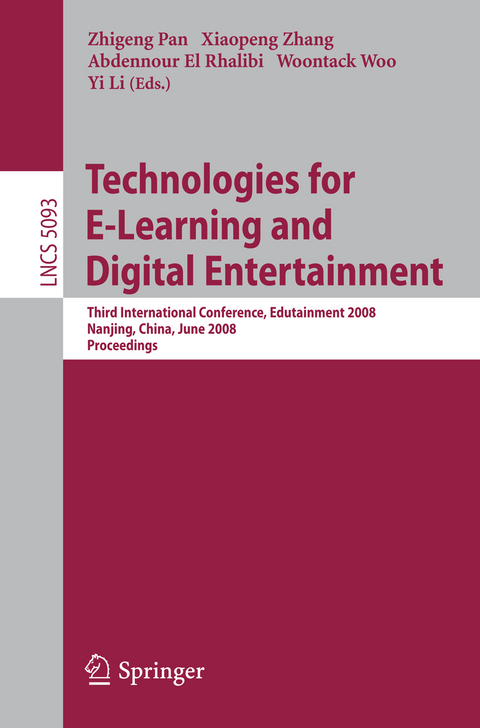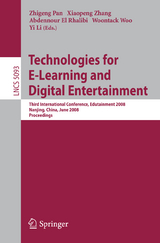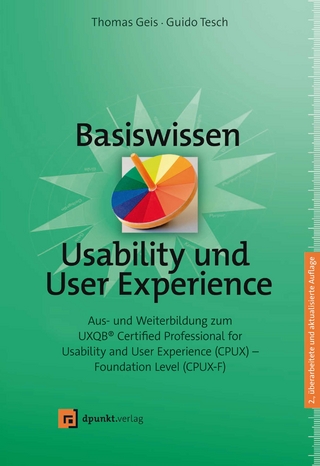Technologies for E-Learning and Digital Entertainment
Springer Berlin (Verlag)
978-3-540-69734-3 (ISBN)
E-Learning Platforms and Tools.- WRITE: Writing Revision Instrument for Teaching English.- u-Teacher: Ubiquitous Learning Approach.- A Model for Knowledge Innovation in Online Learning Community.- The Design of Software Architecture for E-Learning Platforms.- An Educational Component-Based Digital TV Middleware for the Brazilian's System.- Designing and Developing Process-Oriented Network Courseware: IMS Learning Design Approach.- Design and Implementation of Game-Based Learning Environment for Scientific Inquiry.- Research and Implementation of Web-Based E-Learning Course Auto-generating Platform.- E-Learning System for Education.- A Humanized Mandarin e-Learning System Based on Pervasive Computing.- An Interactive Simulator for Information Communication Models.- iThaiSTAR - A Low Cost Humanoid Robot for Entertainment and Teaching Thai Dances.- The Study on Visualization Systems for Computer-Supported Collaborative Learning.- Computer-Assisted Paper Wrapping with Visualization.- Hangeul Learning System.- An Ajax-Based Terminology System for E-Learning 2.0.- Idea and Practice for Paperless Education.- SyTroN: Virtual Desk for Collaborative, Tele-operated and Tele-learning System with Real Devices.- Application of E-Learning Systems.- An Examination of Students' Perception of Blended E-Learning in Chinese Higher Education.- Research and Application of Learning Activity Management System in College and University E-Learning.- Motivate the Learners to Practice English through Playing with Chatbot CSIEC.- A Strategy for Selecting Super-Peer in P2P and Grid Based Hybrid System.- Personal Knowledge Management in E-Learning Era.- Teaching Machine Learning to Design Students.- A Survey on Use of "New Perspective English Learning System" among UniversityStudents-Case Study on Jiangxi Normal University.- Evolving Game NPCs Based on Concurrent Evolutionary Neural Networks.- E-Learning Resource Management.- Knowledge Discovery by Network Visualization.- Research on Emotional Vocabulary-Driven Personalized Music Retrieval.- Research on Update Service in Learning Resources Management System.- On Retrieval of Flash Animations Based on Visual Features.- The Design of Web-Based Intelligent Item Bank.- Methods on Educational Resource Development and Application.- Research on Management of Resource Virtualization Based on Network.- The F-R Model of Teaching in Chinese Universities.- An Approach to a Visual Semantic Query for Document Retrieval.- Modification of Web Content According to the User Requirements.- Virtual Environments with Content Sharing.- Interaction in Game and Education.- Hand Contour Tracking Using Condensation and Partitioned Sampling.- Integrating Gesture Recognition in Airplane Seats for In-Flight Entertainment.- Designing Engaging Interaction with Contextual Patterns for an Educational Game.- Design and Implement of Game Speech Interaction Based on Speech Synthesis Technique.- Two-Arm Haptic Force-Feedbacked Aid for the Shoulder and Elbow Telerehabilitation.- Vision Based Pose Recognition in Video Game.- Memotice Board: A Notice Board with Spatio-temporal Memory.- Mobile Cultural Heritage: The Case Study of Locri.- Integration of Game and Education.- Study of Game Scheme for Elementary Historical Education.- Integration of Game Elements with Role Play in Collaborative Learning - A Case Study of Quasi-GBL in Chinese Higher Education.- A Case of 3D Educational Game Design and Implementation.- Mathematical Education Game Based on Augmented Reality.- Game-Based Learning Scenes Design for IndividualUser in the Ubiquitous Learning Environment.- Learning Models for the Integration of Adaptive Educational Games in Virtual Learning Environments.- The Potential of Interactive Digital Storytelling for the Creation of Educational Computer Games.- Game Design and Development.- Designing Virtual Players for Game Simulations in a Pedagogical Environment: A Case Study.- The Relationship between Game Genres, Learning Techniques and Learning Styles in Educational Computer Games.- EFM: A Model for Educational Game Design.- Towards Generalised Accessibility of Computer Games.- Designing Narratology-Based Educational Games with Non-players.- Interactive Game Development with a Projector-Camera System.- Animated Impostors Manipulation for Real-Time Display in Games Design.- Virtual Characters, Animation and Navigation.- Virtual Avatar Enhanced Nonverbal Communication from Mobile Phones to PCs.- Analysis of Role Behavior in Collaborative Network Learning.- Survey on Real-Time Crowds Simulation.- TS-Animation: A Track-Based Sketching Animation System.- Dynamic Axial Curve -Pair Based Deformation.- 3D Freehand Canvas.- Sparse Key Points Controlled Animation for Individual Face Model.- Networked Virtual Marionette Theater.- Tour into Virtual Environment in the Style of Pencil Drawing.- Research and Implementation of Hybrid Tracking Techniques in Augmented Museum Tour System.- Graphics Rendering and Digital Media.- Terrain Synthesis Based on Microscopic Terrain Feature.- A Double Domain Based Robust Digital Image Watermarking Scheme.- ABF Based Face Texturing.- Tile-Based Interactive Texture Design.- Efficient Method for Point-Based Rendering on GPUs.- Efficient Mushroom Cloud Simulation on GPU.- Geometric Modeling in Games and Virtual Reality.- Virtual Artistic Paper-Cut.- ASufficient Condition for Uniform Convergence of Stationary p-Subdivision Scheme.- Model and Animate Plant Leaf Wilting.- The Technical Research and System Realization of 3D Garment Fitting System Based on Improved Collision-Check Algorithm.- Reconstruction of Tree Crown Shape from Scanned Data.- A Survey of Modeling and Rendering Trees.- Creating Boundary Curves of Point-Set Models in Interactive Environment.- Rational Biquartic Interpolating Surface Based on Function Values.- 3D Modelling for Metamorphosis for Animation.
| Erscheint lt. Verlag | 7.7.2008 |
|---|---|
| Reihe/Serie | Information Systems and Applications, incl. Internet/Web, and HCI | Lecture Notes in Computer Science |
| Zusatzinfo | XVII, 791 p. |
| Verlagsort | Berlin |
| Sprache | englisch |
| Maße | 155 x 235 mm |
| Gewicht | 1229 g |
| Themenwelt | Mathematik / Informatik ► Informatik ► Betriebssysteme / Server |
| Informatik ► Software Entwicklung ► User Interfaces (HCI) | |
| Schlagworte | Animation • augmented reality • cellular phone • Collaborative Learning • Computer Games • digital entertainment • educational entertainment • Edutainment • E-Learning • Entertainment Computing • flash animation • Game-based Learning • Game Design • game physics • game rendering • gesture recogni • gesture recognition • Haptic Devices • Hardcover, Softcover / Informatik, EDV/Betriebssysteme, Benutzeroberflächen • HCI • HC/Informatik, EDV/Betriebssysteme, Benutzeroberflächen • Intelligent Agents • knowledge management • machine learning • Modeling • Multimedia Learning • network courseware • Online gaming • Online Learning • P2P • PDA • Pervasive Computing • Racter • Resource Management • resource sharing • resource virtualization • Scalability • scientific inquiry • security • semantic web • Software Product Lines • Speech Synthesis • Teaching • user-generated contents • virtual learning • Virtual Reality • visual interface • Visualization • VRML • Web Services |
| ISBN-10 | 3-540-69734-9 / 3540697349 |
| ISBN-13 | 978-3-540-69734-3 / 9783540697343 |
| Zustand | Neuware |
| Haben Sie eine Frage zum Produkt? |
aus dem Bereich




